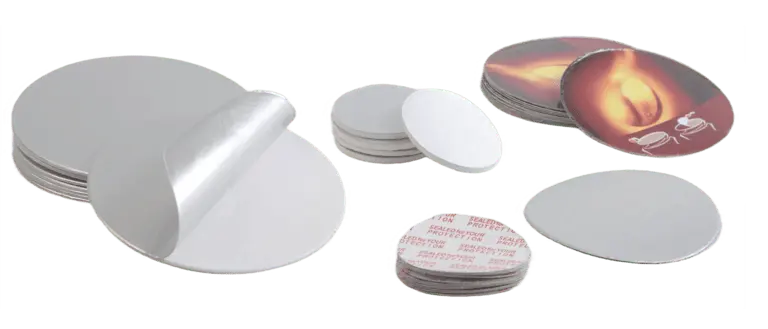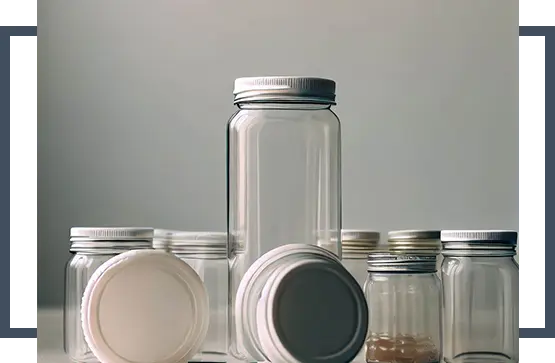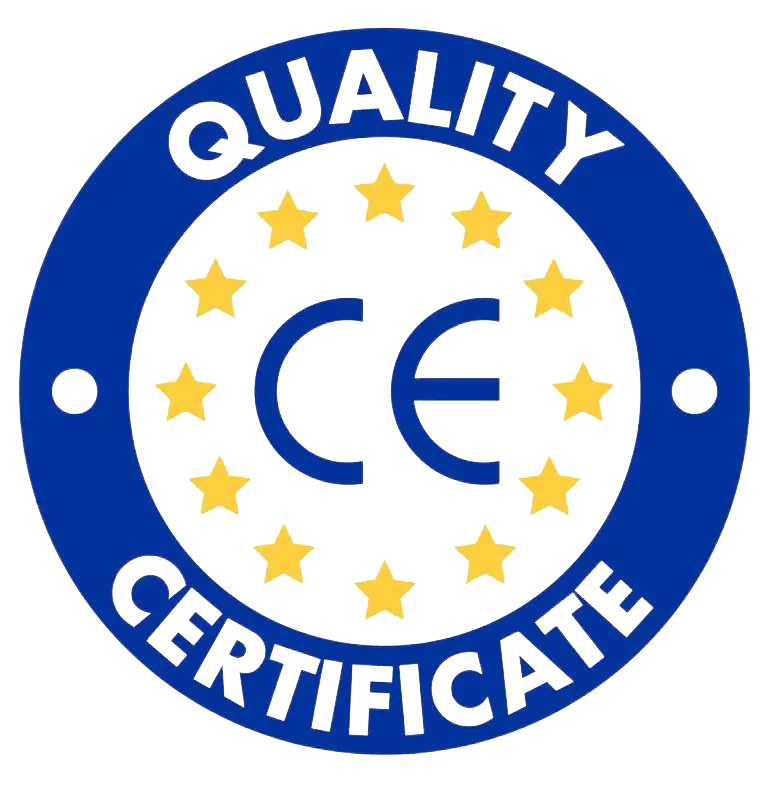For all types of containers and the highest quality induction sealing washers
One of the most important factors for achieving high-quality induction sealing is using the appropriate induction sealing liner
For all types of materials
Highest quality
Reasonable price

Paperboard induction sealing liners, which are divided into two types—removable and non-removable—consist of four layers: a thin film matching the container material, aluminum of varying thicknesses, a special adhesive, and paperboard. This type of liner is widely used for sealing and protecting products. It is suitable for sealing various types of PET jars, polyethylene, polypropylene, polyester containers, various gallon containers, and nearly any container with a screw or snap-on lid.
Advantages:
- Usable across all industries and for almost all lidded containers
- Attractive appearance
Disadvantages:
- Higher cost due to the inclusion of paperboard
Capabilities:
- Removable and non-removable options
- Available in various thicknesses
- Printing possible on foil and paperboard

Foam Induction Sealing Liners are primarily used for sealing plastic jugs and bottles, and are commonly employed in non-food applications. The components of foam seals include four layers: compressed thin film, aluminum of varying thicknesses, a special adhesive, and foam. After sealing, the foam along with the other layers remains on the container and can be easily removed.
Advantages:
- Cost-effective
- Suitable for containers with irregular openings
- Tear-resistant due to the foam layer on aluminum
Disadvantages:
- Generally not used for food and hygienic applications
- Foam may not separate easily from the aluminum
Capabilities:
- Printing on aluminum
- Available in various thicknesses

Single-Layer Induction Sealing Liners are used for sealing almost all types of plastic containers across various industries. Examples include PET jars, polyethylene, polypropylene, polyester containers, and various types of jugs. These liners consist of three layers: a thin film of the container material, aluminum, and a PVC coating.
Advantages:
- Tear Resistance: High thickness provides resistance to tearing.
- Corrosion Resistance: Effective against corrosive substances such as acids and solvents.
- Aesthetic Appeal: Attractive and well-presented.
- Versatility: Suitable for a range of plastic containers.
Features:
- Easy and Hard-to-Open Options: Available in both easy and hard-to-open versions.
- Custom and General Printing: Options for both custom and general printing.
Disadvantages:
- Limited Use: Typically used for containers where there is no gap between the bottom of the lid and the container’s opening after sealing.

Induction foil has relatively minimal use compared to other induction sealing liners and is mainly used for plastic containers such as PET, polyethylene, and PP. This type of liner consists of two layers: aluminum and a film or laminate made from the plastic material of the container. Similar to single-layer liners, none of the layers are separable or detachable. Due to the challenging placement compared to other liners inside the cap, these foils are often used in specific applications, particularly for containers that can be sealed but do not have caps, such as disposable paper cups, PET, and polyethylene. Additionally, due to its cost-effectiveness, it can be used to reduce production costs for products that do not have a high value. Other applications for these liners include plastic, glass, and crystal containers.
Induction sealing liners are made of several compressed layers, tailored to the type of container. Each container has its own specific sealing liner, with laminated aluminum being the primary base material in all cases. For plastic containers such as PET, polyethylene, PP, polyester, and others, a film layer or, more simply, a thin layer of the same material as the container is laminated onto the aluminum in various thicknesses. Depending on the type of lid and how it seals, additional layers such as cardboard, foam, or PVC are bonded to the laminated aluminum using a substance called wax, which acts like adhesive. When the induction sealing liner is exposed to the magnetic field generated by the induction sealing machine, the aluminum’s conductive properties create molecular movement in this layer, raising its temperature. This heat is transferred to the lower layer, causing it to bond to the container’s opening. In other words, the heating of the aluminum warms the thin laminate layer on top, which then acts as an adhesive.
-
Utilizing the highest quality materials, including aluminum, film or laminate, wax, cardboard, foam, and PVC laminate, which are resistant to temperature increases and do not exhibit undesirable reactions such as smoking or producing unpleasant odors. Otherwise, the product could be severely damaged and become unusable.
-
Ensuring the hygiene of necessary layers when required
-
Resistance to impacts caused by transportation and handling
-
Uniform and complete sealing on the container's opening without leakage or spillage

Beauty and Protection
Bottle packaging has become an art combining aesthetics and protection. This process not only creates appealing and attractive appearances but also utilizes advanced technologies and materials to safeguard and extend the shelf life of the contents. Bottles with well-designed packaging not only attract customers’ attention but also ensure optimal preservation of the content, while also contributing to environmental sustainability. Additionally, inspired by creativity and art, bottle packaging has evolved into a new level of connection between customers and their products.





